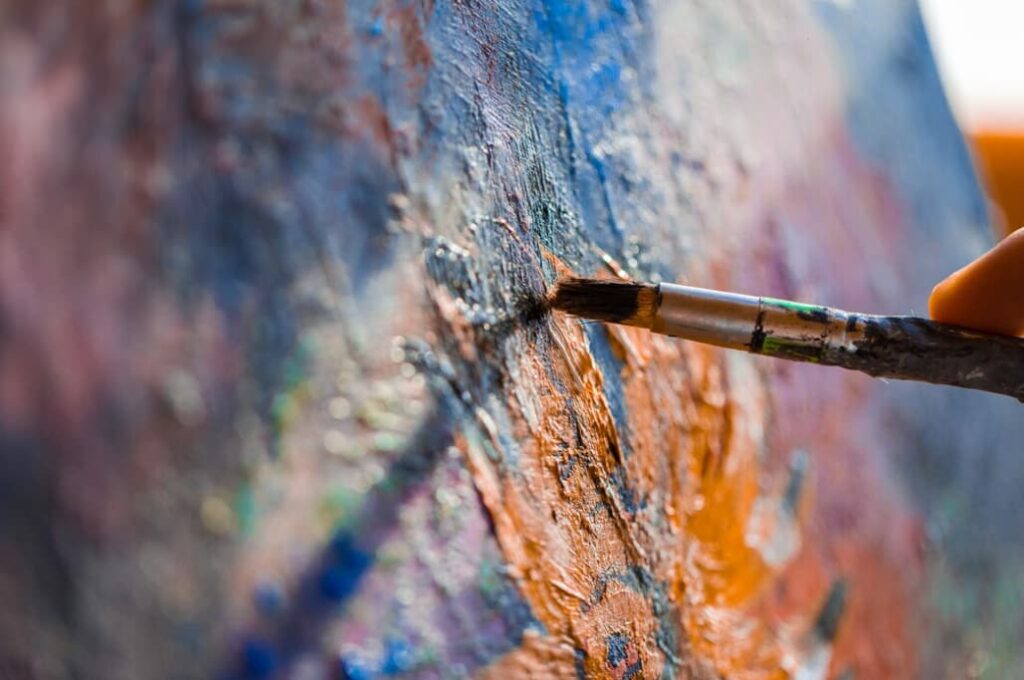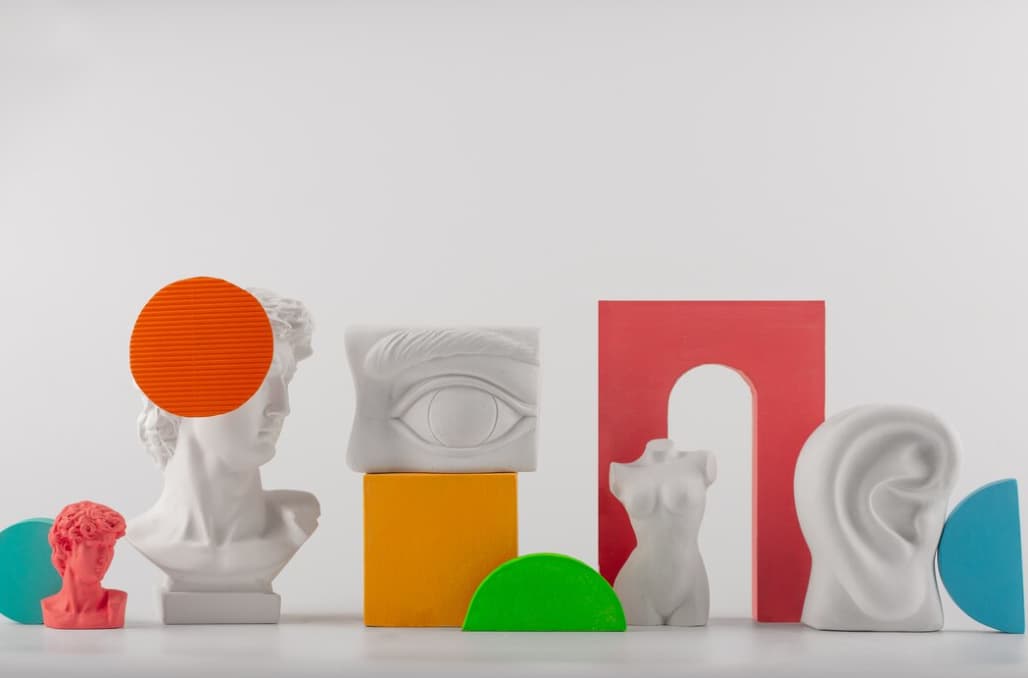Contrary to common misconception, the foundational rules guiding artistic creation, known as the principles of art, are separate from the basic components known as the elements of art. The seven fundamental elements of art, which were covered earlier, serve as the essential ingredients for crafting any piece of art. The discussion on the role of aesthetic colors in design provided insights into how color choices impact design outcomes. Next, attention shifts to the broader principles of art, where the fundamental concepts that guide artistic creation are examined.
Today, we will delve into the principles of art, which we can liken to the adhesive that binds the elements together. Often referred to as the principles of design, they include:
- Rhythm;
- Balance;
- Emphasis;
- Gradation;
- Harmony;
- Variety;
- Movement;
- Proportion.
Insights on Composition in Artwork
Understanding composition in art is key to guiding the observer’s gaze, offering a structured perception of the artwork from the main focus to other aspects in a ranked order of significance. Art principles act as a guide for creating compositions that are both visually appealing and successful.
While certain principles might appear more crucial, artists should aim to comprehend each one, recognizing their potential to either elevate or detract from their work’s overall impact. Over time, this understanding will cultivate an innate ability to mix these principles optimally in every piece, achieved through thoughtful examination and practice.
Balance: A Fundamental Principle
Balance, a fundamental principle in art, provides a harmonious distribution of visual elements within an artwork. When this equilibrium is missing, it can lead to a feeling of unease in those viewing the piece.
Creating a composition that feels balanced can be achieved using different methods, such as symmetry, asymmetry, or radial symmetry:
| Type of Symmetry | Description |
|---|---|
| Symmetry | This involves having both sides of the artwork mirror each other. |
| Asymmetry | Both halves of the art piece are not identical, but the visual weight is evenly distributed, maintaining balance. |
| Radial symmetry | Characterized by a distribution of similar weights around a central focal point. |
The Role of Proportion in Art
Proportion refers to the relative size of one component or element in comparison to another. It also depicts how different parts of an artwork fit together. Establishing accurate proportions can bring vitality to your artwork, especially for portraits, depending on the style used.
To harness the full potential of proportions in your artwork, you need to understand scales and positions. Misrepresentation of scale can deprive your drawing of a sense of proportion and scale. Introducing overlap between objects can help discern which item is in perspective, imparting a sense of harmony to your artwork.
Rhythm in Art: Creating Fluidity
Rhythm in art is synonymous with patterns and repetition. It encapsulates the visual tempo of your work, created through the repeated use of elements. However, overuse of repetition can make an artwork monotonous.
Rhythms can have several types, each adding a unique flavor to your artwork:
- Random rhythm: These patterns have an organic feel and lack a precise pattern;
- Regular rhythm: These rhythms recur in a predictable manner and can become monotonous;
- Alternating rhythm: This is characterized by a back-and-forth sequence of two elements;
- Flowing rhythm: This describes an artwork that showcases elements with fluid, curvy movements;
- Progressive rhythm: These patterns depict a gradual shift in size or pace.
Emphasis: The Art of Focus

Emphasis in art serves as a visual strategy that guides the observer’s gaze toward the most important aspect of the piece. This selective focus is crafted through the artist’s deliberate use of standout colors, stark contrasts, or the purposeful arrangement of objects within the composition. While it’s possible for an artwork to have several points of interest, having too many competing focal points can lead to a cluttered perception and diminish the intended impact on the viewer. It is often recommended that artists be judicious in their use of emphasis to create a clear narrative or point of interest, ensuring that the observer’s experience is coherent and their attention is not scattered.
Gradation: Adding Depth to Your Art
Gradation, on the other hand, is a subtle but powerful principle that adds a dimension of realism and depth to artwork. It’s a technique that delights the eye, commonly referred to in the context of color where one hue transitions smoothly to another, or in value where lightness shifts to darkness. However, the concept of gradation extends beyond these elements; it can also apply to the progressive alteration of size, the transformation of shape, and the evolution of textures within a piece. By applying gradation, artists can create a sense of movement and lead the viewer’s eye seamlessly from one part of the work to another, effectively unifying the different components of the artwork into a cohesive whole.
Harmony: Fostering Unity in Art
Harmony in art describes how the various components of an artwork collaborate towards a cohesive vision or idea. Achieving visual harmony involves integrating similar or related elements, including:
- Suitable color combinations;
- Corresponding shapes;
- Compatible textures.
Nevertheless, it’s essential to introduce an element of contrast to prevent the artwork from appearing monotonous.
Variety: The Spice of Art
Incorporating variety is crucial for producing captivating artwork, as it serves to balance unity by adding diverse elements and contrasts to the visual mix. By intentionally incorporating a range of shapes, colors, textures, and structures, the artist creates a visually rich and stimulating experience. This diversity adds a dynamic character to the piece. The skill of the artist lies in their ability to blend these varied elements harmoniously, aligning them with the fundamental principles of art. When variety is effectively integrated, it ensures the artwork strikes a balance between being engaging without becoming overwhelming, thus keeping the viewer’s interest piqued.
Movement: Breathing Life into Art
Movement within an artwork is a dynamic principle that infuses a static image with the illusion of action or flow. It is not just the representation of things in motion but also encompasses the guiding of the viewer’s eye across the canvas. Movement can be implied through a variety of techniques, such as the strategic placement of objects along a perceived line of motion, or through the use of direction and fluidity in brushwork. Artists can also create a narrative of movement by arranging elements in a way that suggests a sequence of events. This principle is vital for breathing life into a piece, making the viewer feel as if they are witnessing a moment frozen in time, with the potential to unfurl before their eyes.
Texture: Enhancing the Feel of Art

Texture in art is an element that refers to the surface quality or ‘feel’ of an object within the artwork. It’s a feature that can dramatically enhance the sensory appeal of a piece, inviting not only visual scrutiny but also the impulse to touch. Texture can manifest in two primary ways: actual texture, which can be felt with the touch in three-dimensional art forms, and visual texture, which is created through illusion in two-dimensional artworks. The strategic use of texture can provoke various emotional reactions, from the comfort of smoothness to the tension of roughness, and adds a level of complexity and richness to the artwork. It is a powerful tool that, when skillfully employed, can contribute significantly to the depth and realism of the piece.
Space: The Silent Contributor in Art
Space in art is often regarded as the canvas’s breath, the unspoken yet profoundly influential element of composition. It is the ‘canvas silence’ that speaks volumes, shaping the context in which the subject exists. Positive space is the area occupied by your subject, while negative space is the unoccupied open areas. Both are crucial in defining the boundaries of the artwork and can dramatically alter its interpretation. The intelligent manipulation of space can provide a stage for the artwork’s elements to shine, creating a rhythm between presence and absence that can guide the viewer’s gaze and enhance the overall impact of the piece. Properly managed, space serves not just as a backdrop but as an active participant in the artwork’s narrative, contributing to the balance, contrast, and effectiveness of the visual story being told.
Conclusion
Learning and mastering the elements and principles of art is a rewarding process. This knowledge is crucial for improving your artistic compositions and developing your own style. Each principle has an important role in the overall look of the artwork, and it’s the artist’s job to use them effectively. Keep creating and remember that art is a personal expression. Please share any questions or thoughts in the comments, and let’s keep learning about art together.
Gaining a strong understanding of the principles of art is essential for artists to create impactful and emotionally resonant work. These principles act as a framework that brings together the basic elements of art, creating a cohesive and effective whole. The principles, like balance, rhythm, and movement, provide various ways to enhance an artwork’s appeal. Artists can refine their unique style by continuously learning and applying these principles. Remember, the journey of art involves constant learning and evolving, with every step offering new insights.
